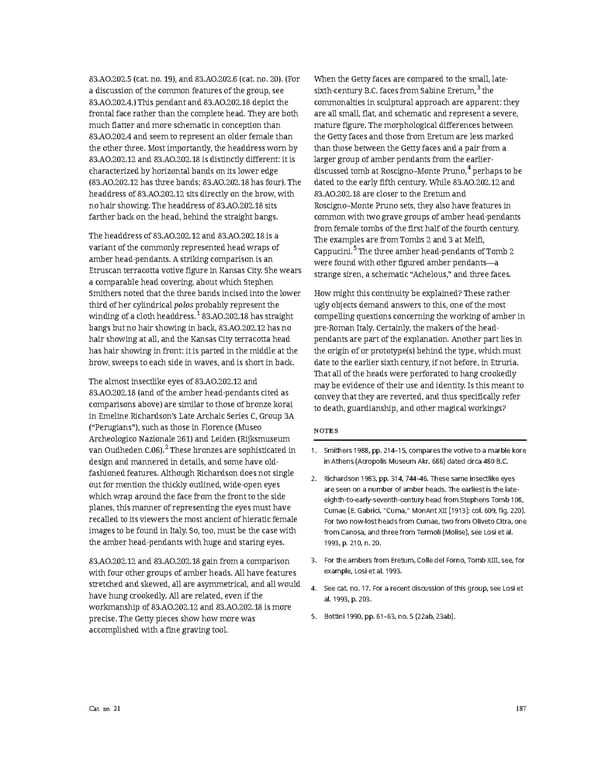83.AO.202.5 (cat. no. 19), and 83.AO.202.6 (cat. no. 20). (For When the Getty faces are compared to the small, late- a discussion of the common features of the group, see sixth-century B.C. faces from Sabine Eretum,3 the 83.AO.202.4.) This pendant and 83.AO.202.18 depict the commonalties in sculptural approach are apparent: they frontal face rather than the complete head. They are both are all small, flat, and schematic and represent a severe, much flatter and more schematic in conception than mature figure. The morphological differences between 83.AO.202.4 and seem to represent an older female than the Getty faces and those from Eretum are less marked the other three. Most importantly, the headdress worn by than those between the Getty faces and a pair from a 83.AO.202.12 and 83.AO.202.18 is distinctly different: it is larger group of amber pendants from the earlier- characterized by horizontal bands on its lower edge discussed tomb at Roscigno–Monte Pruno,4 perhaps to be (83.AO.202.12 has three bands; 83.AO.202.18 has four). The dated to the early fifth century. While 83.AO.202.12 and headdress of 83.AO.202.12 sits directly on the brow, with 83.AO.202.18 are closer to the Eretum and no hair showing. The headdress of 83.AO.202.18 sits Roscigno–Monte Pruno sets, they also have features in farther back on the head, behind the straight bangs. common with two grave groups of amber head-pendants from female tombs of the first half of the fourth century. The headdress of 83.AO.202.12 and 83.AO.202.18 is a The examples are from Tombs 2 and 3 at Melfi, variant of the commonly represented head wraps of Cappucini.5 The three amber head-pendants of Tomb 2 amber head-pendants. A striking comparison is an were found with other figured amber pendants—a Etruscan terracotta votive figure in Kansas City. She wears strange siren, a schematic “Achelous,” and three faces. a comparable head covering, about which Stephen Smithers noted that the three bands incised into the lower How might this continuity be explained? These rather third of her cylindrical polos probably represent the ugly objects demand answers to this, one of the most winding of a cloth headdress.1 83.AO.202.18 has straight compelling questions concerning the working of amber in bangs but no hair showing in back, 83.AO.202.12 has no pre-Roman Italy. Certainly, the makers of the head- hair showing at all, and the Kansas City terracotta head pendants are part of the explanation. Another part lies in has hair showing in front: it is parted in the middle at the the origin of or prototype(s) behind the type, which must brow, sweeps to each side in waves, and is short in back. date to the earlier sixth century, if not before, in Etruria. That all of the heads were perforated to hang crookedly The almost insectlike eyes of 83.AO.202.12 and may be evidence of their use and identity. Is this meant to 83.AO.202.18 (and of the amber head-pendants cited as convey that they are reverted, and thus specifically refer comparisons above) are similar to those of bronze korai to death, guardianship, and other magical workings? in Emeline Richardson’s Late Archaic Series C, Group 3A (“Perugians”), such as those in Florence (Museo NOTES Archeologico Nazionale 261) and Leiden (Rijksmuseum van Oudheden C.06).2 These bronzes are sophisticated in 1. Smithers 1988, pp. 214–15, compares the votive to a marble kore design and mannered in details, and some have old- in Athens (Acropolis Museum Akr. 688) dated circa 480 B.C. fashioned features. Although Richardson does not single 2. Richardson 1983, pp. 314, 744–46. These same insectlike eyes out for mention the thickly outlined, wide-open eyes are seen on a number of amber heads. The earliest is the late- which wrap around the face from the front to the side eighth-to-early-seventh-century head from Stephens Tomb 108, planes, this manner of representing the eyes must have Cumae (E. Gabrici, “Cuma,” MonAnt XII [1913]: col. 609, fig. 220). recalled to its viewers the most ancient of hieratic female For two now-lost heads from Cumae, two from Oliveto Citra, one images to be found in Italy. So, too, must be the case with from Canosa, and three from Termoli (Molise), see Losi et al. the amber head-pendants with huge and staring eyes. 1993, p. 210, n. 20. 83.AO.202.12 and 83.AO.202.18 gain from a comparison 3. For the ambers from Eretum, Colle del Forno, Tomb XIII, see, for with four other groups of amber heads. All have features example,Losi et al. 1993. stretched and skewed, all are asymmetrical, and all would 4. Seecat. no. 17. For a recent discussion of this group, see Losi et have hung crookedly. All are related, even if the al. 1993, p. 203. workmanship of 83.AO.202.12 and 83.AO.202.18 is more precise. The Getty pieces show how more was 5. Bottini 1990, pp. 61–63, no. 5 (22ab, 23ab). accomplished with a fine graving tool. Cat. no. 21 187
 Ancient Carved Ambers in the J. Paul Getty Museum Page 196 Page 198
Ancient Carved Ambers in the J. Paul Getty Museum Page 196 Page 198